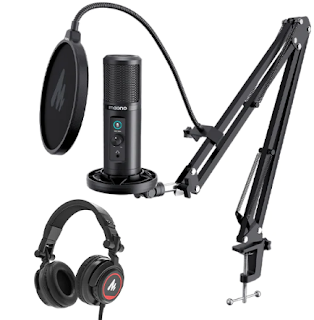USB Microphone for Podcasting: Elevating Audio Quality and Convenience
In the world of
podcasting, high-quality audio is paramount to captivate and retain listeners.
A USB microphone has emerged as a game-changer for podcasters, offering a
simple and effective solution to achieve professional-grade audio recordings
without the need for complex setups. In this article, we will explore the
benefits of using a USB microphone for podcasting, its features, and why it has
become the go-to choice for both aspiring and experienced podcasters.
1. What is a USB
Microphone for Podcasting?
usb
microphone for podcasting is a type of microphone that connects
directly to a computer or other compatible devices through a USB port. Unlike
traditional microphones, USB microphones don't require additional audio
interfaces or mixers to function. They come equipped with an integrated
analog-to-digital converter, allowing them to convert audio signals into
digital format, making them easy to plug-and-play with computers or laptops.
2. Features and
Benefits of USB Microphones for Podcasting:
a. Plug-and-Play
Convenience: One of the primary advantages of a USB microphone is its
simplicity. You can connect it directly to your computer, and it's ready to use
without any driver installations or complex configurations.
b. Audio Quality: USB
microphones are designed with high-quality components, resulting in clear and
crisp audio recordings. Many models offer features like condenser capsules and
built-in shock mounts to reduce unwanted noise and vibrations.
c. Versatility: USB
microphones are versatile and can be used for various recording purposes beyond
podcasting, such as voiceovers, gaming, streaming, and online meetings.
d. Portability: USB
microphones are compact and lightweight, making them highly portable and
suitable for on-the-go podcasting or recording sessions.
e. Real-Time
Monitoring: Some USB microphones offer a headphone output with zero-latency
monitoring, allowing you to hear your voice in real-time without any delay,
ensuring precise recording.
f. Budget-Friendly: USB
microphones offer a cost-effective solution for achieving professional audio
quality without the need for investing in additional audio equipment.
3. Tips for Choosing
the Right USB Microphone:
a. Consider Your
Recording Environment: Choose a USB microphone with a suitable polar pattern
(cardioid, omnidirectional, or bidirectional) based on your recording
environment and desired sound pickup.
b. Audio Quality: Look
for USB microphones with high-bitrate and sample rate options for better audio
resolution.
c. Additional Features:
Some USB microphones come with gain control, mute buttons, and volume
adjustment, enhancing your control over the recording process.
d. Compatibility:
Ensure that the USB microphone is compatible with your operating system
(Windows, macOS, or Linux) and any recording software you plan to use.
4. Setting Up Your USB
Microphone:
a. Connect the USB
microphone to an available USB port on your computer or laptop.
b. Open your recording
software or podcasting platform and select the USB microphone as your audio
input device.
c. Adjust the
microphone's gain level to ensure optimal recording volume without distortion.
d. Use headphones for
monitoring to ensure the audio quality during recording.
In conclusion, a USB
microphone for podcasting is a powerful tool that empowers podcasters with
professional-grade audio quality and user-friendly operation. Its convenience,
portability, and versatility have made it a preferred choice for content
creators, streamers, and online communicators worldwide. Whether you are a
seasoned podcaster or just starting, a USB microphone can elevate your audio
recordings and help you deliver compelling content that resonates with your
audience.
For
more info. visit us:


Comments
Post a Comment